Last updated on October 14, 2023
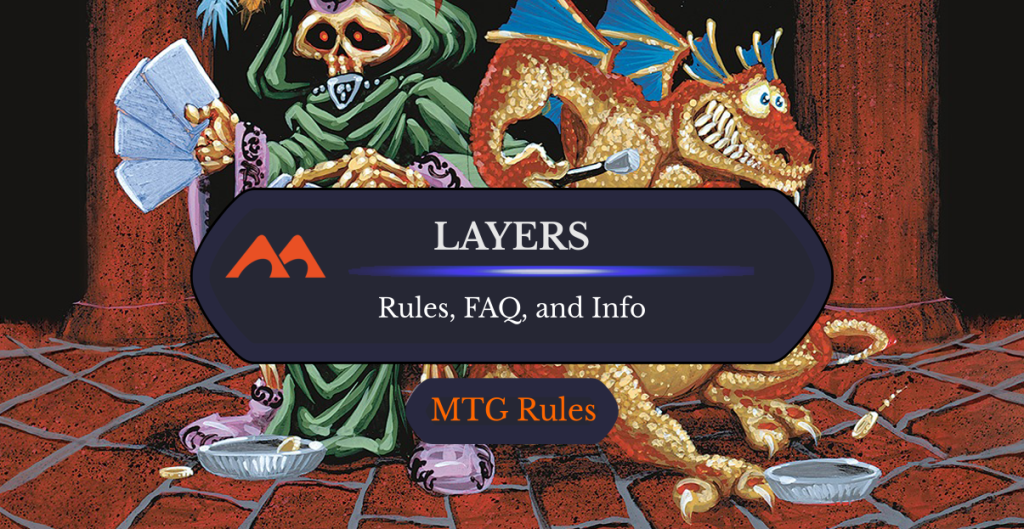
Humility | Illustration by Phil Foglio
Onions have layers. Ogres have layers. You get it? We both have layers.
For Magic players in the know, the very word conjures all sorts of horror stories of weird rules interactions that don't look like they should work. For aspiring judges, layers can be among the more difficult rules to learn. As a former level 2 judge with a wealth of competitive-level experience I'm here to tell you that layers are much easier than the folklore surrounding them would suggest.
Layer rules do get very wordy and it may take a few reads to absorb. But once you know them the questions involving them become much easier. Today I'm going to go in depth on this crazy side of the Magic rules and explain exactly why dumb cards like Humility and Blood Moon end up working the way they do.
Ready? Let's get into it!
What Are Layers in MTG?
Layers are a way to manage what happens when multiple continuous effects are trying to apply to the same game object. You start with the original object (like a card exactly how it was printed with no modifiers) when applying multiple continuous effects to an object, and apply each of its applicable continuous effects in the order of the layers system.
Each of the seven possible characteristics that you can change has its own layer and needs to be applied in the right order. The seventh layer is also broken down into four sublayers because there are a lot of ways to modify that characteristic.
What Are Continuous Effects in MTG?
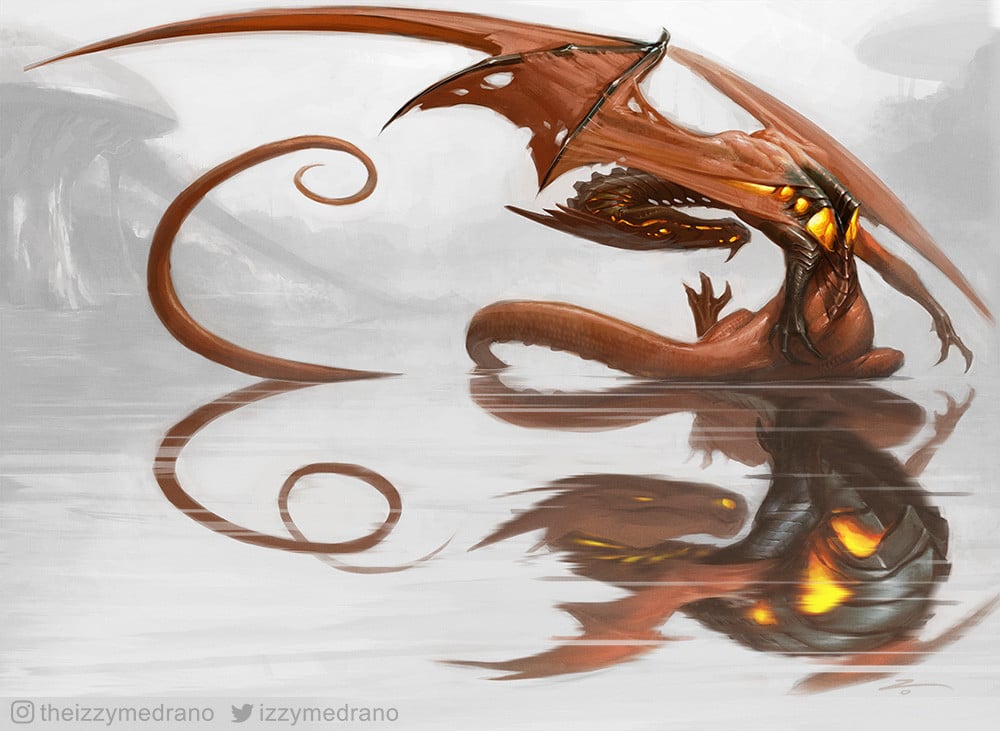
Twisted Image | Illustration by Izzy Medrano
Continuous effects modify the characteristics of objects in a game of Magic for either a fixed or indeterminate amount of time. Seven different characteristics of game objects can be modified by effects in the game.


For example, you can change the power and/or toughness of a creature by using Giant Growth, give creatures extra abilities with Akroma's Memorial, or even alter their text with Return to Ravnica‘s overload mechanic. All of these are continuous effects, and layers are the set of rules that determine in what order to apply these effects if several are trying to modify the same object.
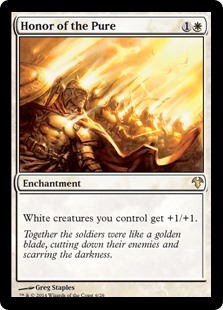
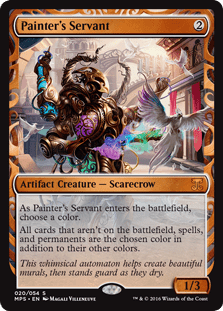
Let's look at Honor of the Pure as an example. It gives all your white creatures +1/+1. You'd assume that if you had an effect that turned all your creatures white, like Painter's Servant, that would then mean they all get buffed by Honor of the Pure. And you'd be right. This is thanks to how layers work. In this example they dictate that all effects that change an object's color are applied before effects that change their power and/or toughness.
In What Order Are Layers Applied in MTG?
The order in which you apply the layers is as follows.
- Copy effects like Clone or Mirrorweave.
- Control changing effects like Agent of Treachery or Control Magic.
- Text changing effects like Sleight of Mind or the overload mechanic (see Mizzium Mortars).
- Type changing effects like Blood Moon or Arcane Adaptation.
- Color changing effects like Snakeform or Painter's Servant.
- Effects that add or remove abilities like Humility or Akroma's Memorial.
- Power- and/or toughness-changing effects. There are a lot of different kinds and they're applied in the following order:
- Characteristic-defining abilities (also known as CDAs) like those on Tarmogoyf or Necrogoyf. Basically any ability that determines the value of a * on that creature's power/toughness.
- Effects that set “base” power and toughness like Ensoul Artifact or Witness Protection.
- Effects and counters that modify power and/or toughness like Giant Growth, Dead Weight or +1/+1 or -1/-1 counters.
- Effects that switch power and toughness like Inside Out or Twisted Image
What Happens if a Continuous Effect Applies to Multiple Layers?

There are several effects that apply to multiple layers. For example, combat tricks that give a power and toughness boost and a keyword ability like Moment of Heroism. This should be applied in two separate layers, six and seven to be precise.

Some cards, like Snakeform, can apply to several layers. If this is the case, you apply each part of this effect separately, in each layer it would apply. In the case of Snakeform, the target becomes a snake first (layer four), then becomes green (layer five), then loses its abilities (layer six), and finally becomes a 1/1 (layer seven).
Let’s have a look at a few common (and annoying) examples of layers in action.
A Classic Layer Seven Example
It’s possible to apply multiple power- and toughness-changing effects to the same creature, so you have to know how to apply each of these effects. For this example, let’s start with a simple Forest Bear, mainly because I love the artwork. It’s a 2/2 vanilla creature. Then these things happen:
- You cast Refuse to Yield, giving it +2/+7.
- Your opponent casts Startle to give it -2/-0.
- You cast Twisted Image to switch its power and toughness.
- Your opponent enchants it with Witness Protection.
- You cast Titanic Growth to give it +4/+4.
You need to apply these effects in the order specified by layer seven’s sublayers. There are no CDAs in play so you apply layer 7b first (Witness Protection turns your creature into a 1/1), then layer 7c (your three effects combine to give a total of +4/+11, making your creature a 5/12), and finally layer 7d (you switch your creature’s power and toughness, resulting in a 12/5).
Magus of the Moon vs. Humility
This is probably the most classic layers question in the game. You might think that because Humility can remove creature abilities, it can just remove Magus of the Moon‘s ability and your lands will be freed from its grip. But layers have something to say about that.
Magus of the Moon applies in layer four (changing card types) and Humility applies in layer six (removing abilities). So you apply Magus first, turning all non-basic lands into Mountains, and then you try to apply Humility in layer six. But Magus has already been applied so there’s nothing of note to be removed. At least Magus will now be a 1/1 thanks to the other part of Humility’s effect.
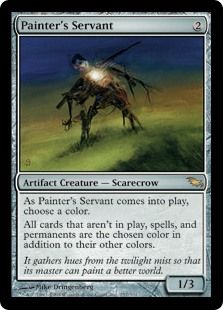
This is also true of any other similar interaction. If a creature has an ability that affects any of the first five layers, those abilities can't be removed. Painter's Servant is another classic example that won’t be removed since it's applied in layer five.
What Happens if Multiple Continuous Effects Apply in the Same Layer?
It’s important to note that there’s one problem with the layers system. It’s fine for when you have multiple different kinds of continuous effects all applying at once, but what if there are multiple effects that apply in the same layer? What order do you apply them in?
For that you have one of the most difficult-to-understand sections of the rules. This is exactly the part of layers that most people struggle to understand. Hopefully my explanation will do it justice.
What Are Timestamps in MTG?
Timestamps are how you determine the order to apply continuous effects that are interacting in the same layer. Each continuous effect is assigned a timestamp as soon as it starts to be generated.
There are several ways this might happen. Most permanents (see below for auras and equipment) get timestamps when they enter the battlefield, as do the effects generated by their static abilities. Effects generated from spells or activated/triggered abilities receive a timestamp when those spells/abilities resolve. In most cases you apply multiple effects in the same layer in the order of their timestamps.
You basically apply things in the order they first came into effect. Hopefully that makes some sense, but let’s look at a couple examples.
Blood Moon vs. Dryad of the Ilysian Grove
Blood Moon comes up quite a bit when talking about layers. It’s trying to turn all non-basic lands into Mountains, effectively removing all their abilities and making them only tap for red mana. This applies in layer four.
Dryad of the Ilysian Grove gives all five of the basic land types to your lands, also applied in layer four. Since both are just the static abilities of permanents, they get timestamps when they enter the battlefield.
If Blood Moon entered before Dryad of the Ilysian Grove, all your non-basic lands are turned into Mountains and then given each of the other basic land types. The result is that all your non-basic lands will have all five basic land types, but Blood Moon removed all their abilities.
But if Dryad entered first, your non-basic lands get each of the basic land types and then Blood Moon overwrites their types and turns them all into Mountains.
Colossus Hammer vs. Flight
Modern aficionados among you will be aware of Colossus Hammer, but how does it interact with a card like Flight that gives the flying ability? First of all, it’s important to note that equipment and auras get new timestamps when they become attached to something.
If you have a creature enchanted with Flight and then you equip it with Colossus Hammer, Hammer get a new timestamp which is later than Flight’s, so the creature gets flying from Flight and then loses it thanks to Colossus Hammer.
But if you have a creature equipped with Colossus Hammer and then you enchant it with Flight, it loses flying first but then gains it afterwards, resulting in a flying creature.
What Are Dependencies in MTG?
Maybe you’ve heard about dependencies before. If you have, I'm very sorry. Maybe some of you picked up on when I said you apply timestamps in “most” cases.
Dependencies are a separate system that override timestamps, but they don’t come up very often. The explanation can get a little bit dense, but hopefully the examples I give you clear it up. If two effects are operating in the same layer, you can look for what's called a dependency. There's a very long-winded explanation of what these are and how to spot them, but I can try to boil it down.
If you have two effects, A and B, and applying A before B would alter how B works, what it applies to or removes it entirely, then you apply A first. In this case, B is dependent on A.
If a dependency exists, then you apply the dependent effect (in this case, effect A) first. If effect B is then removed, it won't be applied. If it’s modified, you then re-evaluate if it has any further dependencies and apply all remaining effects in timestamp order.
This explanation made very little sense to me when I first tried to learn dependencies. It’s much easier to view in practice, so let’s look at two of the most common examples.
Blood Moon vs. Urborg, Tomb of Yawgmoth
The best-known example of dependencies is Blood Moon vs. Urborg, Tomb of Yawgmoth. While this looks like the earlier example of how Blood Moon interacts with Dryad of the Ilysian Grove, there’s one key difference: Urborg, Tomb of Yawgmoth is a land so it's also subject to these two effects, while Dryad wasn't.
If you apply Blood Moon’s effect to Urborg, then Urborg’s effect gets removed. This means that Urborg is dependent on Blood Moon. Regardless of which one entered the battlefield first, Blood Moon will always be applied first and since Urborg’s ability now doesn’t exist, it doesn’t apply at all.
Basically, Blood Moon always wins.
Humility vs. Slivers
Yup, we’re back to everyone’s favorite layers-centric card: Humility. Slivers are well-known for being themed around giving each other various keyword abilities. For the sake of this example, let’s use Lancer Sliver, which gives all your slivers first strike. If you were to apply timestamps, then playing Lancer Sliver when there’s a Humility already on the battlefield still grants first strike to your slivers.
But you have a dependency to apply. These two cards both apply in the same layer, with Humility trying to remove Lancer Sliver’s ability. This makes Lancer Sliver (and most other slivers by extension) dependent on Humility. So you always apply Humility first and since doing so removes Lancer Sliver’s ability, that no longer applies.
Basically, Humility always wins.
What Layer Is Twisted Image On?
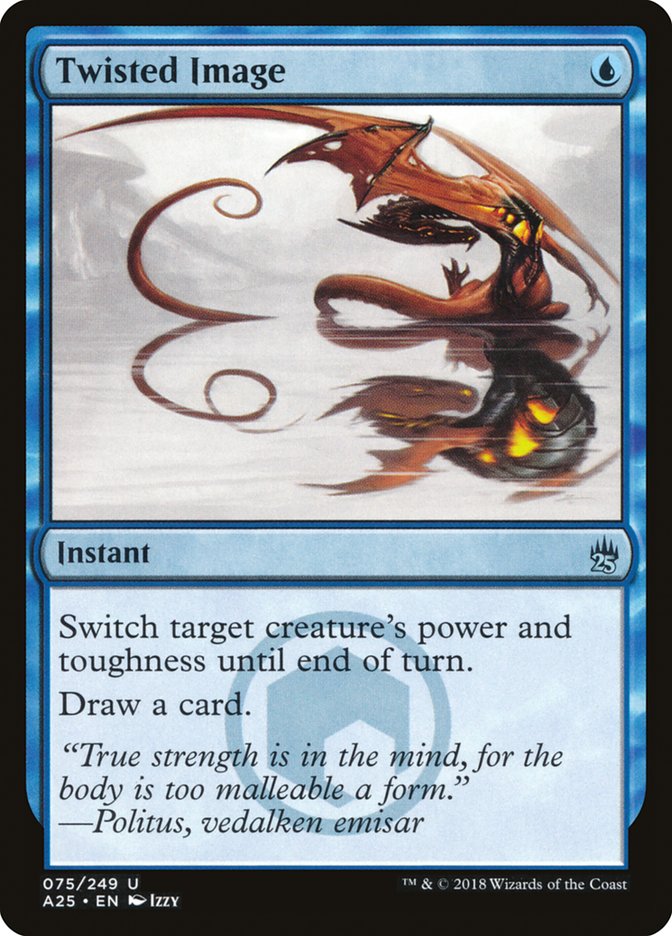
Twisted Image and other power/toughness-switching effects apply in layer seven. This is a very important layer to learn if you’re maybe looking to become a judge yourself.
Layer seven is all that’s required in the knowledge base for level one, while the rest of the layers are covered in level two. You should get very familiar with layer seven, particularly with how these kinds of effects work.
What Layer Is Humility On?
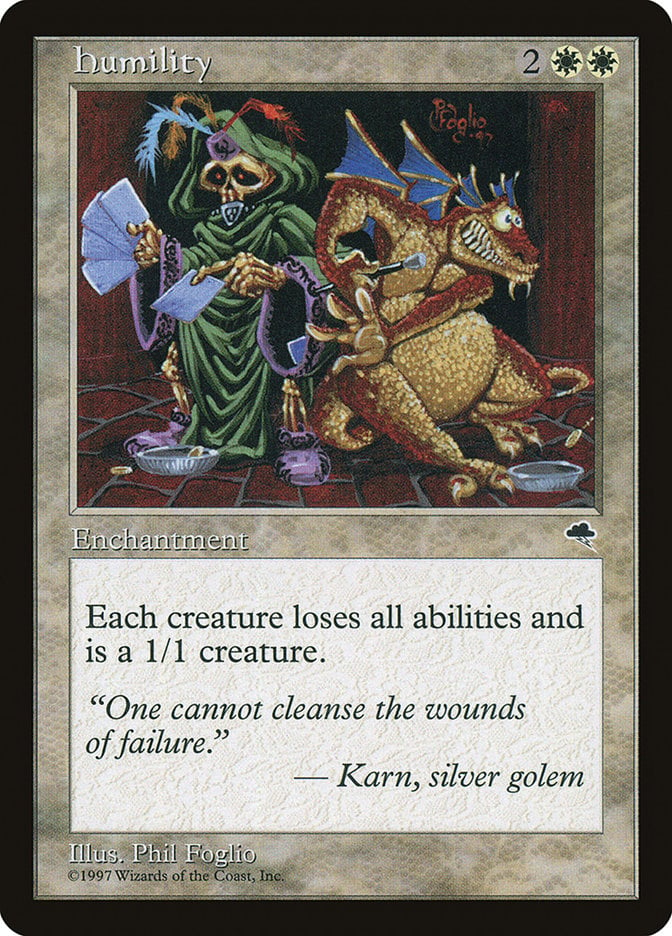
Humility might be the single most famous layer card in the game. It applies on layer six to remove creatures’ abilities and again on layer seven to set base power and toughness.
As I mentioned earlier, the fact that it applies on layer six means that it doesn’t remove abilities that would apply on earlier layers, like those of Magus of the Moon or Painter's Servant.
What Layer Is Opalescence On?
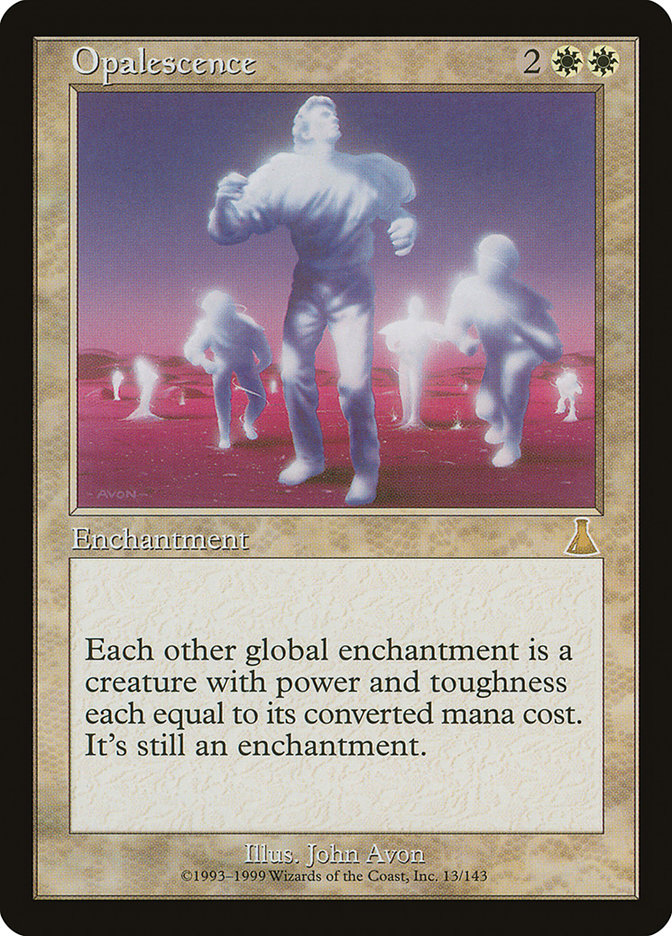
Opalescence is another silly layer card, applying first on layer four to change card types and then again on layer seven to set base power and toughness. That leads you to one of the most famous layers questions in the game: how do Opalescence and Humility interact?
The answer is that both Opalescence and Humility apply in full. While Humility tries to remove its own ability, it continues to apply in full because it already started to apply. Whether your enchantments end up as 1/1s or 4/4s is decided by the timestamp rules.
What Layer Is Blood Moon On?
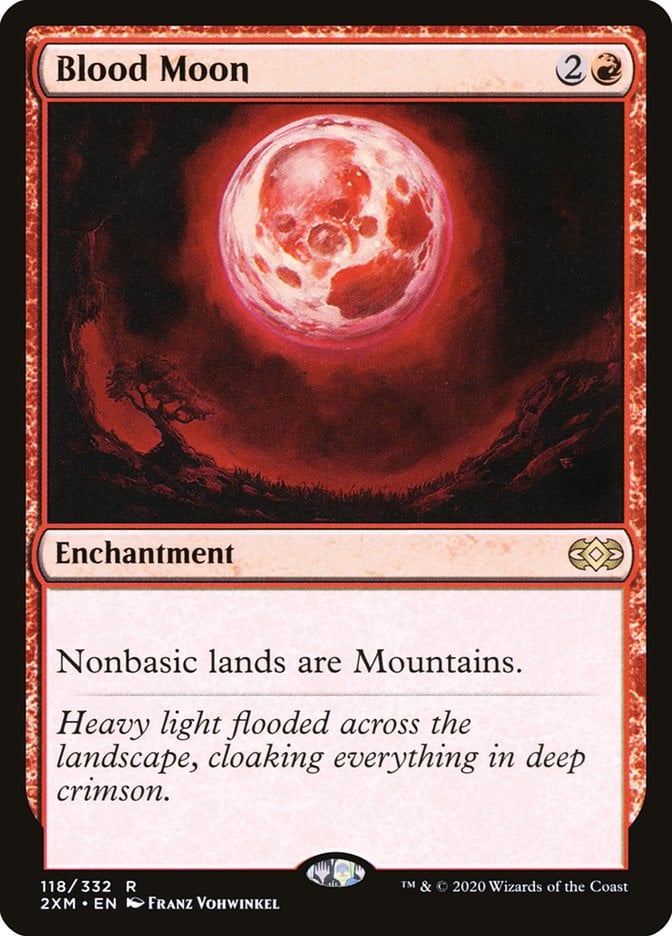
Blood Moon applies entirely on layer four, for changing card types. While a lot of the rulings surrounding it are solved by applying timestamps, it’s very possible to end up with dependencies like with Urborg, Tomb of Yawgmoth and Yavimaya, Cradle of Growth.
Wrap Up
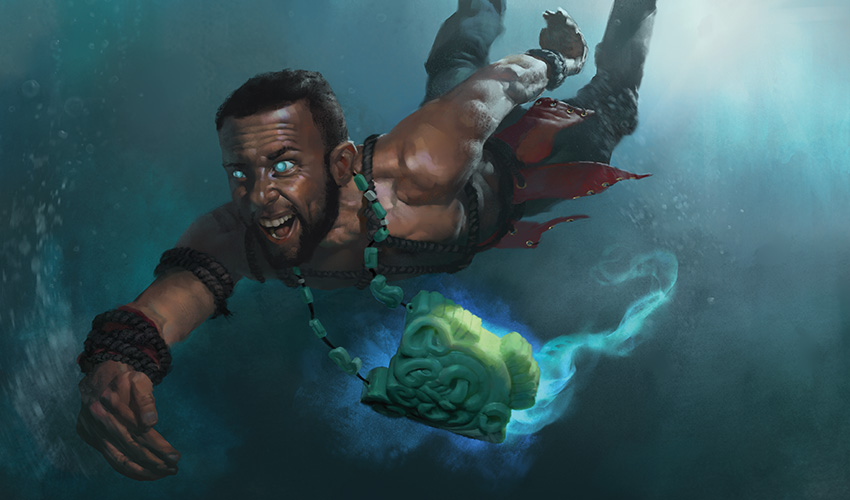
Arcane Adaptation | Illustration by Mark Behm
Layers can be very difficult to figure out. They make absolutely no sense at first, but they become quite intuitive once you get used to them. Looking at the situations without knowing how layers work could be like learning calculus without having learned algebra. Or even learning algebra without learning your times tables (or your order of operations).
I just hope that my explanations helped you learn how layers work. If you have any questions or need more clarification, feel free to pop down into the comments below or ask them over in the Draftsim Discord.
Follow Draftsim for awesome articles and set updates: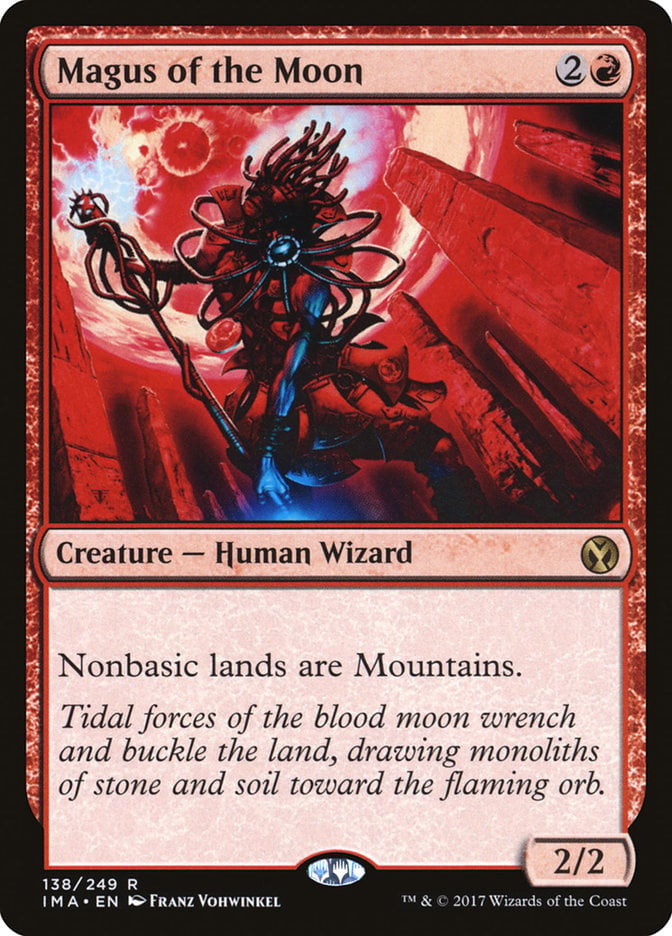
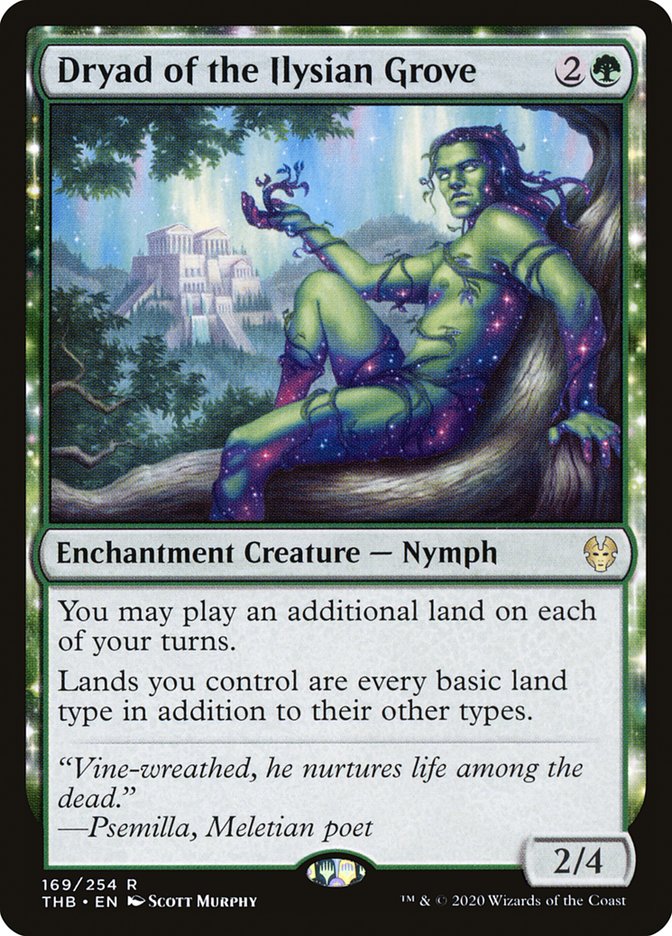
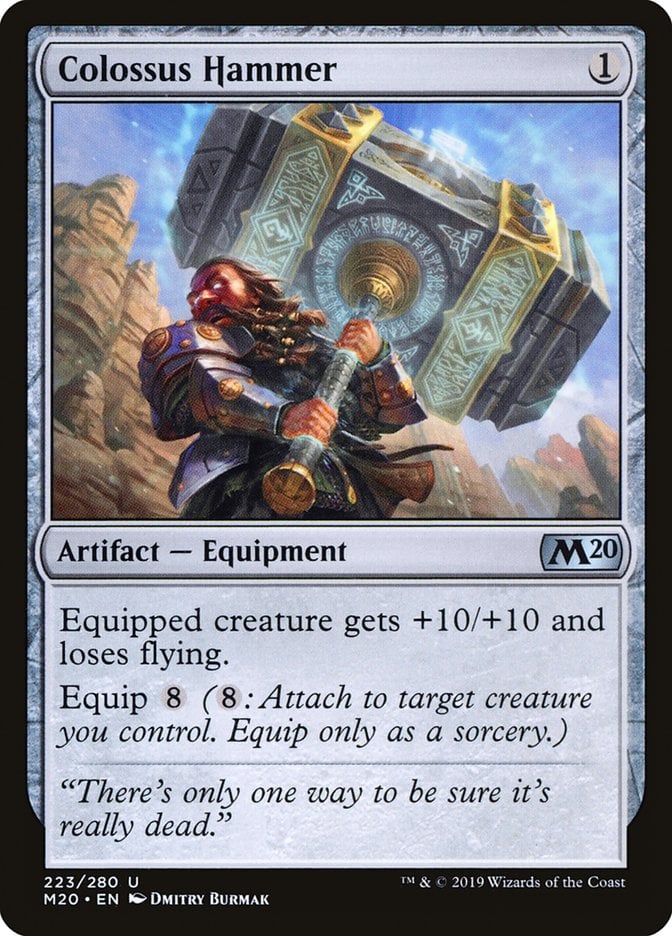
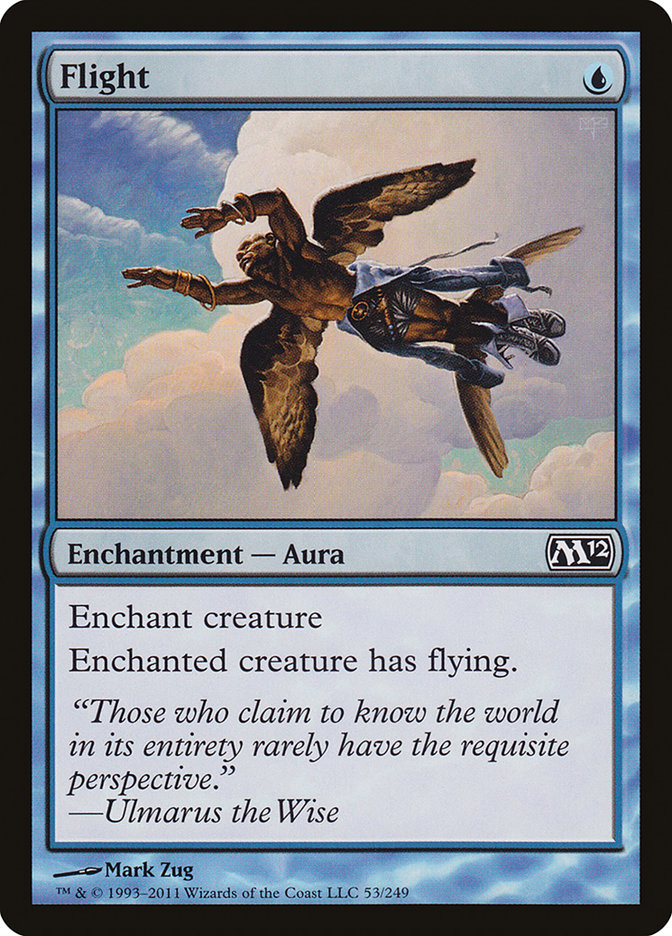
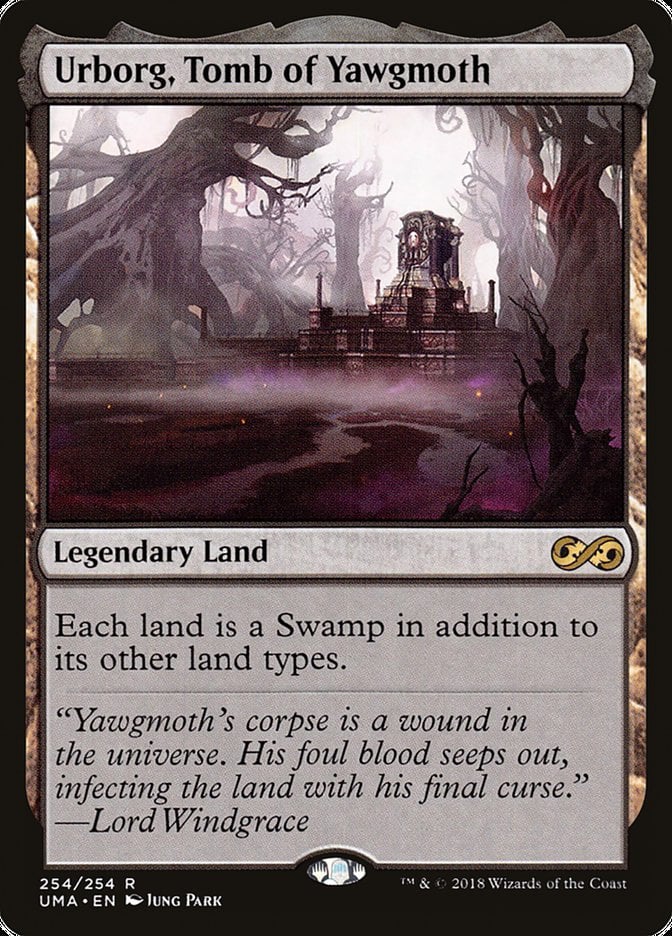
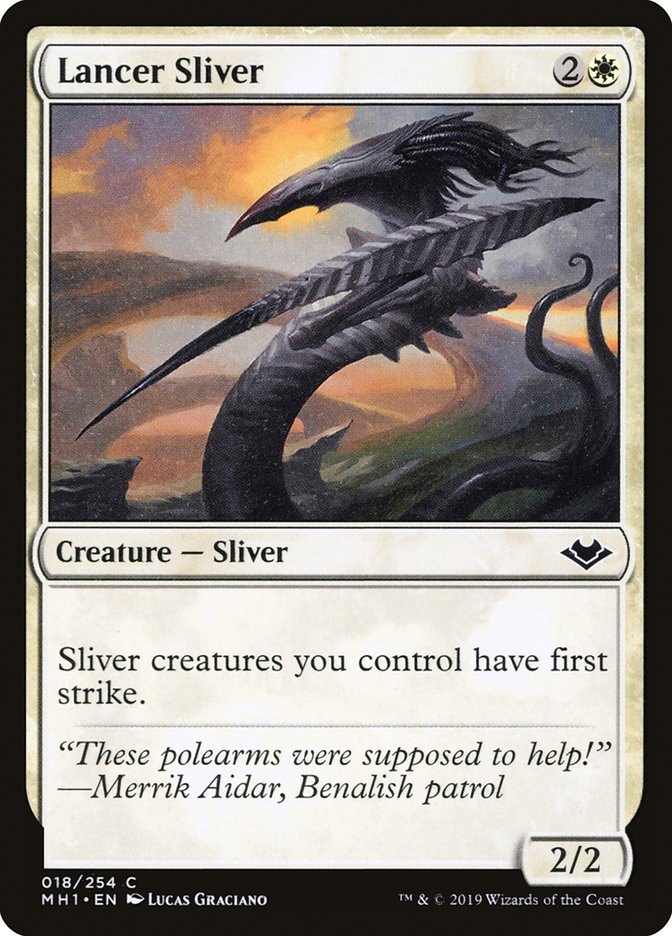
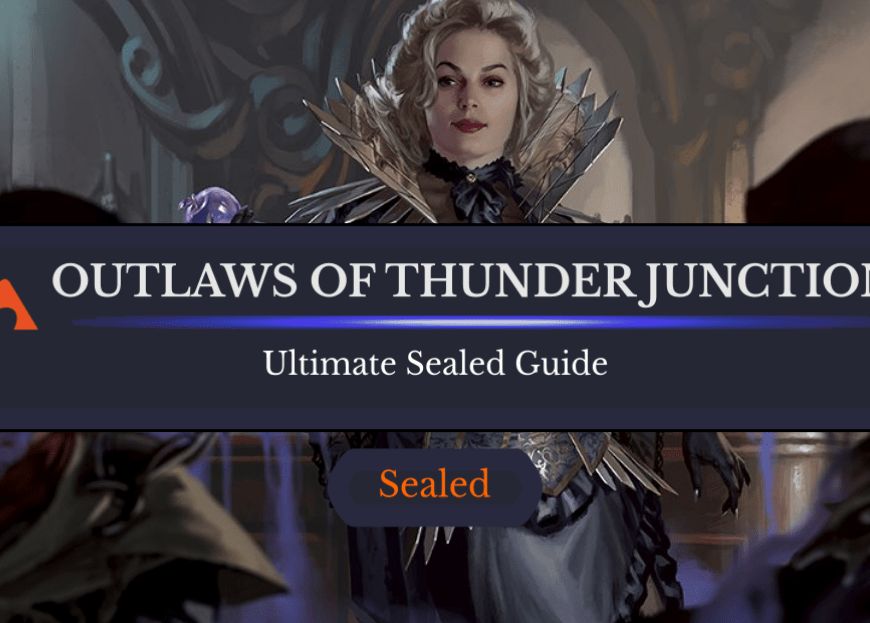

5 Comments
Layers are ridiculous and over complicating. In my commander pod we play “Fast Clean Magic” and so ignore layers in favour of a strict LIFO “Last In First Out” application of effects. We don’t play competitive events and so can (thankfully) ignore the complexity of layers.
Please comment on Dress Down and Tarmogoyf as that’s a strong point of contention. It’s not suppose to be a 0/1 according to this layer application.
What part of the article would mean it wouldn’t be a 0/1? We gave a quick read through and there shouldn’t be an issue, but if there’s something we need to change to make it more clear please let me know. Thanks!
Dress Down applies in layer 6, removing all abilities from Tarmogofy, including its CDA, which would have applied in Layer 7.
In Layer 7, Tarmogoyf tries to work out its Power, which should be *, but has no CDA to set it, so that’s 0. It tries to work out its Toughness, which should be 1+ *, but * is still zero, so the resulting toughness is 1.
You could definitley argue that * is undefined and so treated as zero, and that 1+* is also undefined and thus treated as zero, but I think the printed 1 in the text box is doing a lot of work here. Either way, it’s not the layer system that affects this ruling.
Thank you for this explanation; I don’t think I was aware of layers, as I’m only a very casual player of MtG, but it makes sense now. Along with timestamps and dependencies, I ought to play more and get involved.
Add Comment